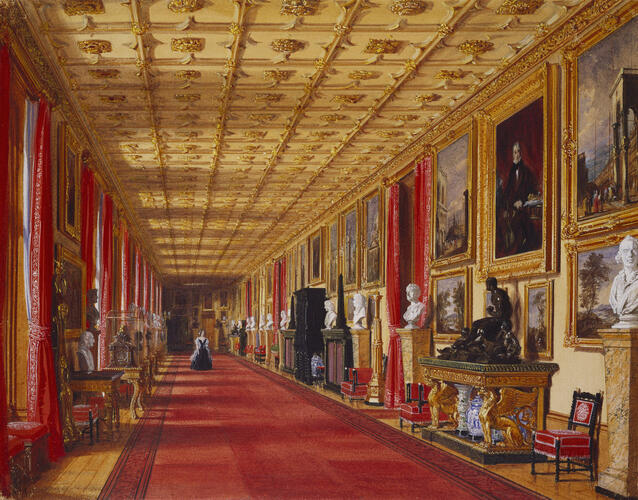-
1 of 253523 objects
The south section of the Grand Corridor, Windsor Castle dated 1846
Pencil, watercolour and bodycolour | 33.0 x 42.4 cm (whole object) | RCIN 919782

Joseph Nash (1809-78)
The south section of the Grand Corridor, Windsor Castle dated 1846

Joseph Nash (1809-78)
The south section of the Grand Corridor, Windsor Castle dated 1846


-
A watercolour view of part of the Grand Corridor at Windsor Castle; a figure, perhaps representing the Queen, approaches. Signed and dated at bottom left: Joseph Nash 1846.
The Grand Corridor, constructed by Jeffry Wyatville on the east and south sides of the Upper Ward between 1824 and 1828, was George IV's most extensive and novel addition to the castle. It was 137 metres long and 4.6 metres broad, providing a new means of access to the adjacent royal and visitors' apartments and, more significantly, a place for the King to display some of the choicest paintings, furniture and objets d'art in his collection. It has remained little changed to this day.
The views of the Corridor by Joseph Nash, painted eighteen years after it was completed, provide the earliest visual evidence of George IV's decorative scheme and arrangement of contents. The latter was devised with the help of two of the King's favourite artists, the painter Sir David Wilkie and the sculptor Sir Francis Chantrey. The sculpture - chiefly busts - was chosen to commemorate British monarchs, historical personages, friends and contemporaries. The paintings included a magnificent group of Venetian views by Canaletto, Zuccarelli and the Riccis, purchased from Consul Smith by George III; some of Frederick, Prince of Wales's hunting pictures by Wootton; and a selection of late eighteenth- and early nineteenth-century portraits. The picture frames were either specially made or carefully adapted to suit this new setting. The furniture included an outstanding group of Boulle, a number of clocks, several examples of English giltwood, Indian ebony chairs, and modern oak stools and benches in the Gothic style (designed by A.W.N. Pugin), together with a rich selection of cabinet bronzes and objets d'art.
The decoration, carried out by Morel & Seddon, included the provision of forty-one pairs of curtains made of red and cream 'English tapestry' (also used on the seat furniture), a red Gothic-pattern carpet and forty-nine yellow scagliola pedestals for the busts. Lighting was provided by forty-two gilded iron torchères in the Gothic style, also designed by the younger Pugin. The richness of the contents made - and continues to make - a striking contrast with Wyatville's restrained Gothic detailing, which suggests something of the character of a Tudor long gallery.
Text adapted from the catalogue entry for RCIN 919781 in Royal Treasures, A Golden Jubilee Celebration, London 2002.
Nash appears to have first worked for Victoria and Albert in 1844, when he was commissioned to record events from the visits of, first, the Emperor of Russia and then Louis-Philippe, King of the French. A version of this watercolour was reproduced as a lithograph by Nash in his publication Views of the Interior and Exterior of Windsor Castle (1848), which he dedicated to the Queen. The introduction states: "On the various occasions when the Continental Sovereigns were entertained by Her Majesty at Windsor Castle, Mr Nash had the honour of receiving Her Majesty's commands to make Drawings of the scenes illustrative of the state and ceremony which distinguish the Royal hospitality". As well as such narrative scenes, Nash's publication also included illustrations of rooms and spaces within the Castle (such as this one), which must have been made with Victoria and Albert's permission. Some watercolours by Nash connected with the publication are in the Royal Collection; three were acquired by Victoria and Albert for their watercolour albums, but the majority were purchased in the twentieth century. A complete set of 26 watercolours, which are probably the final works on which the lithographs in the publication were based, is in the collection of Anglesey Abbey (National Trust).Provenance
Purchased by Queen Mary, along with RCIN 919783, from R. Haworth, Blackburn, 1928
-
Creator(s)
Acquirer(s)
-
Medium and techniques
Pencil, watercolour and bodycolour
Measurements
33.0 x 42.4 cm (whole object)
Other number(s)
RL 19782